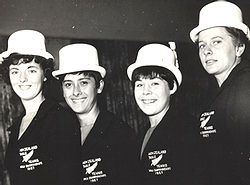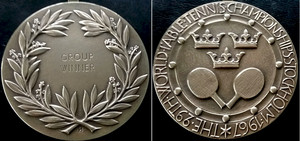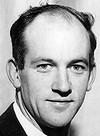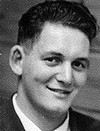Top People |
| Men's Singles Champion |
D Neale (England) |
| Women's Singles Champion |
Miss D L Wade (BP) |
Ranking List |
Men
- B A Foster (O)
- G A J Frew (NL)
- M W Borlase (W)
- A R Tomlinson (A)
- J Armstrong (C)
- T J O'Carroll (NL)
- H J Waterhouse (W)
- G V Wilkinson (A)
- B T Cross (W)
- V N Brightwell (C)
Women
- Miss C E Johnson (H)
- Miss D L Wade (BP)
- Miss V M Rolston (H)
- Miss J E Brown (HV)
- Miss Y M Fogarty (O)
- Miss J M George (NT)
- Mrs K Clegg (NT)
- Miss M Broadbent (WG)
- Mrs M M Costello (A)
- Mrs J F Boswell (FR)
Under 18 Boys
- K J Ward (C)
- R Mitchell (C)
- J T Fisher (A)
- D G Couper (A)
- J Weir (C)
- D A Leong (W)
- A K Joe (EW)
- G Badcock (A)
- F W Beasley (W)
- G J Williams (O)
Under 18 Girls
- Y M Fogarty (O)
- M J Fogarty (O)
- C M Borck (ML)
- J A Cooper (MN)
- A D Johnson (BP)
- C M O'Carroll (NL)
- H M Nicholson (A)
- M P Green (C)
- S J Shirriffs (MN)
- K A Fraser (CW)
|
| Executive Committee |
| J E Stewart (Chair), A R Harding
(Dep Chair), A G Davidson, W S R Jopson, R G Lea, R J Menchi, D E
Berry, Miss J E Brown, N J Taylor, K C Wilkinson (Secretary), A R
Zillwood (Treasurer). |
|
New
Zealand Attends Its Third World Championships (out of 29)
A piece of history was made on 15 March when nine players and a manager boarded an
aircraft in Auckland en route, via Great Britain, to Sweden where they will represent New
Zealand at the 29th World Table Tennis Championships in Stockholm. The 29th championships!
And only the third featuring an officially selected New Zealand team! The last was in
China in 1961 and before that, England in 1954 when only a men’s team competed.
So just attending the Worlds was history making. Also significant was that it was the
largest NZ team ever sent overseas, and that it included four players aged between 15 and
21 specially added for development purposes.
The media coverage generated by this trip was truly phenomenal. It began in 1966 when the
decision to compete was first announced, continued as speculation ran rife regarding
likely selections, was maintained in local regions where players were raising money (the
young players’ selection was conditional on their raising the full cost of the trip)
and moved into top gear in the days before the team departed. It was
then that the dress uniform was unveiled with the women in particular attracting attention
and often featured in full-figure newspaper photographs. Their outfits included stylish
white felt bowler hats, white gloves, tailored black jackets and black handbags. The men
were more traditional with their grey trousers and black blazers. It was
then that the dress uniform was unveiled with the women in particular attracting attention
and often featured in full-figure newspaper photographs. Their outfits included stylish
white felt bowler hats, white gloves, tailored black jackets and black handbags. The men
were more traditional with their grey trousers and black blazers.
Once the team began competing, first in warm-up matches in Scotland and England, then at
Stockholm, newspaper articles of varying sizes giving the results of every contest, and
sometimes all individual matches, began appearing throughout the country with the
players’ home areas being especially liberal with their coverage. Then came the final
burst of publicity after the team returned home, with a manager’s report and all team
members sharing their own stories and their views on the value of the tour.
Clippings of the press coverage were painstakingly preserved by NZTTA Secretary (and team
manager) Ken Wilkinson. 240 separate articles and photographs relating to the trip are
known to have been published.
The men's team was Alan Tomlinson, captain (age 33), Murray Dunn
(31), Bryan Foster (27), Harrison Waterhouse (20), Terry
O’Carroll (19). The women's, as pictured above, left to right: Dawn
Wade (21), Neti Traill (23), Yvonne Fogarty (15),
Cathy Johnson (23). The manager was Ken Wilkinson who
turned 50 while the team was in Great Britain.
It was a well-run World Championship. Swedish fans were ecstatic when their home-grown
stars (Hans Alser and Kjell Johansson) won the men’s doubles. All other major titles
went to Japanese players, and Japan won both the men’s and women’s teams
contests. China did not attend due to internal strife at home.
54 nations and 250 players did compete. New Zealand had travelled the greatest distance.
Our men’s team finished 25th, the women’s 16th. This was slightly ahead of
expectations.
  On their way to their final placing the NZ men faced Ireland to
decide the winner of their group, having gone through their section
contests without a loss. All square at 4-4 New Zealand’s Bryan
Foster faced Irishman Clifford Thompson in the final match. It
went to three but Foster won the third in a canter. As group winners the
team members were each awarded a medal. “I believe the medals (see
right--->) are the
only ones that have been won by NZ at a world championships,” reminisced
Bryan Foster decades later. On their way to their final placing the NZ men faced Ireland to
decide the winner of their group, having gone through their section
contests without a loss. All square at 4-4 New Zealand’s Bryan
Foster faced Irishman Clifford Thompson in the final match. It
went to three but Foster won the third in a canter. As group winners the
team members were each awarded a medal. “I believe the medals (see
right--->) are the
only ones that have been won by NZ at a world championships,” reminisced
Bryan Foster decades later.
Murray Dunn progressed further than any other New Zealander in the
individual events, reaching the fifth round (round of 32). He had a bye in one of the
earlier rounds and tough close 5 game battles in the three matches he won. It was a
sublime performance from Dunn, a veteran now of all three world championships.
Neti Traill won two matches, 15 year old Yvonne Fogarty
did splendidly in such company to win one, and Alan Tomlinson also did
well to reach the semi-finals of the men’s consolation event.
Great Warm-Up in UK
The team had a three-week warm-up in Scotland and England and turned in some great
results. Tomlinson beat England No 2 Dennis Neale in a Yorkshire county match, he beat
England No 5 Brian Wright in the final of the Stevenage Open in Hertford, and was
runner-up in the Scottish Open. Bryan Foster and Neti Traill
won the Scottish mixed doubles, one of several successes for the pair. New Zealand won
four other titles at the Scottish Open: the men’s doubles (Tomlinson and Foster), the
women’s doubles (Fogarty and Johnson), the junior girls (Yvonne Fogarty) and, as the
icing on the cake, Neti Traill won the women’s singles. Neti
Traill and Cathy Johnson won the women’s doubles at the
North England Open, where Yvonne Fogarty added another junior singles
title. Bryan Foster (pictured) beat England’s No 3 (C Warren) in
the Leicester county match.
Lessons Learned
Alan Tomlinson returned home as the best-performed player in the team. He had the
best results in Great Britain and the best singles record in the team contests at the
Worlds. The “find” of the trip was 15-year-old Yvonne Fogarty.
She had been considered by some as a bench-warmer for her older team-mates, selected only
for international experience and as an investment for the future. In the event her results
justified her selection as a full team member on merit alone. She played with Neti Traill
in the two opening team matches, against Norway and USA – both won by NZ.
Lessons from the six week trip abounded when the team landed back in New Zealand on 27
April. Murray Dunn went public with a three point plan: send our top
players to Asia as often as possible; send our top juniors to a Japanese training school;
send a team to every world championships. Yvonne Fogarty was also sought
out by her local Otago press and she stressed the need for New Zealand players to work on
their speed. “The Japanese are fantastically fast,” she said. Team manager Ken
Wilkinson assessed the trip as a success overall. He too emphasised the lack of
speed shown by New Zealanders at this level and also identified serving and receiving
serve as a weakness. He felt Neti Traill and the younger men performed
below their full potential and that Tomlinson, Dunn and Fogarty excelled themselves.
However the trip is evaluated, the fact remains that New Zealand was not outclassed as a
table tennis nation and that nine New Zealand players have now added enormously to their
track record of international experience.
|
Ten
Shillings a Day
This figure (which converted to one dollar after the change to decimal currency on 10
July) was mentioned half-jokingly at the farewell ceremony for our World Championships
team as a nominal amount of pocket money for touring players. “It would be considered
insufficient by most touring teams,” said Vice-President Keith Fraser
(pictured).  “But it would be gratefully accepted by the New Zealand
players.” Mr Fraser went on to say that, not only was NZTTA unable to pay even that
sort of money to its players, the players themselves, their supporters and their
associations had been called on to raise the bulk of the money required to send the team
away. “But it would be gratefully accepted by the New Zealand
players.” Mr Fraser went on to say that, not only was NZTTA unable to pay even that
sort of money to its players, the players themselves, their supporters and their
associations had been called on to raise the bulk of the money required to send the team
away.
England v New Zealand: Five Tests Played
A mere three months after our team returned from the World Championships in Sweden a
further series of international matches took place – this time in New Zealand. The
touring players were from England: Dennis Neale (ranked no 2) and Stuart
Gibbs (no 6). They played five tests, sixteen provincial contests (with
exhibition matches), and competed in the South Island and New Zealand Championships.
They won all their team matches including the five tests and Neale won the men’s
singles and doubles, with Gibbs, at both Championships.
Neale was the better player with a hard-hitting over-the-table game combined with a
delicate touch and a rock-steady temperament. Gibbs was more spectacular and appeared to
scamper about with greater speed. Both players delighted spectators in the exhibition
matches with their powerful driving, acrobatic defence and general agility.
Undoubtedly even our best players were outclassed, though not disgraced. In fact, Alan
Tomlinson managed to beat Gibbs (18 in the fifth) in the Wellington test,
inflicting England’s only loss of the tour. And Tomlinson combined with Bryan
Foster to take a game off the English pair in the doubles match in each of the
first three tests. In the opening match of the first test in Dunedin Foster thrilled his
home crowd by extending Gibbs to five games.
Garry Frew and Tomlinson represented NZ in the fourth test in Auckland
and new international Murray Borlase (pictured) played singles alongside
Tomlinson in the final test in Wanganui. Borlase and Frew combined for the doubles. alongside
Tomlinson in the final test in Wanganui. Borlase and Frew combined for the doubles.
It was a sponsored tour, with Rothmans furnishing publicity material and adding
professional impetus to the promotional effort in general. Despite this, the majority of
the host associations were unable to return a profit from their local fixture. This
resulted in a greater resolve by NZTTA to build up a tour fund, fearing reluctance by
district associations to host such contests in the future.
Nonetheless, the tour attracted considerable media interest, enhancing table tennis’s
already high public profile thanks to the phenomenal coverage given to the World
Championships.
Development Ideas Aplenty
Associations continued to submit development ideas and report on their own development
programmes. Coaching was the predominant activity, with one association (South Canterbury)
presenting coaching talks and films to over 450 school students. The library of each
school in the area was supplied with a book on coaching.
Manawatu conducted a seminar on how to set up and run new clubs; North Taranaki held a
tournament specifically for non-interclub players and Otago instituted representative
matches for lower grade players. A general increase in summer interclub was also reported.
The reports submitted were disseminated throughout the country so the best ideas could be
adopted in other areas.
|
Service
Rule Change
The latest change to the service rule was long overdue in the opinion of the New Zealand
players and officials who attended the World Championships this year and in 1961. The new
rule required the ball to be projected upwards, always in the view of the umpire, and so
that it visibly leaves the palm. It must be struck as it descends from its highest point.
The change was designed to eliminate the widespread practice of dropping the ball onto the
bat or serving straight off the palm.
Poverty Bay Hosts NZ Maori Championships
Fresh from their experience of conducting a successful North Island Championships in 1966,
Poverty Bay Association administrators were involved in the organization and running of
the 2nd Maori Table Tennis Championships held in Gisborne’s YMCA Stadium on 8 July.
Staff of the Department of Maori Affairs and local players were also on the organizing
committee, which was chaired by Frank Powell of Hawke’s Bay TTA.
More than 80 players competed in open and junior events. The men’s singles champion
was J Pere and the women’s J Williams.
University Tournament
A tournament for NZ University students was held in Dunedin in August, comprising
individual events, inter-university team events and a men’s and women’s contest
between a selected NZ Universities team and an Otago representative team.
Canterbury University won the teams event. The men’s singles winner was GK
Jackson, the women’s M Ogle.
Otago won both contests against NZ Universities: 7-5 in the men’s event, 10-2 in the
women’s.
Huge Participation in National Boys Brigade Table Tennis Tournament
Boys Brigade in New Zealand, the organization’s national body, was responsible for
running this tournament – the first on a national basis ever attempted. Over 400
Brigade members participated, representing more than 100 separate companies. Preliminary
rounds were held locally with second rounds conducted in Palmerston North, Hamilton,
Blenheim and Timaru. The finals took place in Wellington, with the matches at this stage
under the supervision of Wellington TTA’s junior selection convenor, Campbell
Harkness. All other aspects of the nationwide event were managed by Brigade
officers.
12th Company, Auckland Battalion won the senior competition and 4th, Timaru the juniors.
|